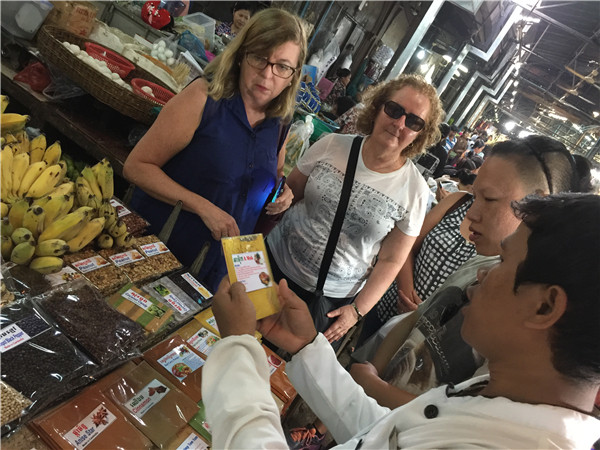Running amok in a good way
After sampling the delectable Sugar Palm version, I was eager to try a more home-cook-friendly version at The Cambodian Cooking Cottage.
Chef Lat Chhunly ("call me 'Charlie'") first takes our group of eight on a whirlwind tour of a local wet market, where we watch locals deboning fish, cleaning morning glory and other greens, wrapping banana flowers and squeezing all kinds of fruits into juice. The chef explains how to use the fruits and vegetables we don't recognize. We pinch, sniff and inhale a stunning array of spices.
Now back at the cooking class, he stops in front of my workstation. I've just begun heating up a splash of chili oil in my wok, with a little amok paste and a dense lump of shrimp paste. In less than a minute, the air becomes incredibly fragrant.
Chef Charlie has a big bowl of coconut milk, a ladle-and a question: "Do you want three scoops of coconut milk? Four? Five?"
Coconut milk is a favorite of many health-food fans who avoid dairy products in their cooking. Nevertheless, the amount of coconut milk I've consumed in the past week of eating Khmer foods would probably drown a Cambodian crocodile.
But the sweet-toothed chef had scooped five ladles of coconut milk into the sample dish of amok he's just made as a demonstration, and it was really yummy.
"Five," I say.
I convince myself that I won't add as much sugar since I've been piggish with the coconut milk.
Fat chance.
By now, with a line of eight woks blazing, the combined scent of lemongrass, galangal, turmeric, kaffir lime leaves and garlic with shrimp paste is enough to induce glassy-eyed delirium. Chef Charlie explains that while amok is a leaf from a specific plant, the dish-like any curry-is actually made with a blend of spices similar to "curry powder". In Cambodia, amok paste usually includes the amok leaf, but because its aroma is short-lived, it's usually absent in the powdered version. The other spices mentioned above do the job very nicely.
As the soupy mix thickens, we add a firm-fleshed fish similar to catfish, chicken broth and some vegetables we've chopped ahead of time. The aroma gets more complex, and in five minutes the dish is ready to eat.



















